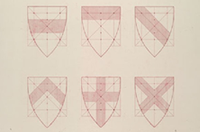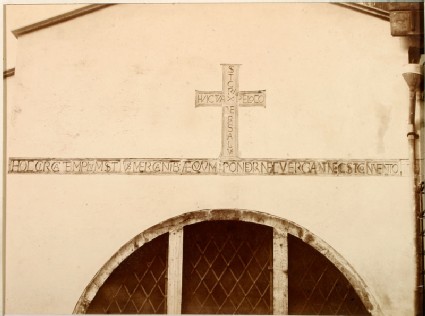Ruskin's revision to the Rudimentary series (1878)
Unpublished manuscript catalogue for proposed re-organisation of the Rudimentary series.

Ruskin's Catalogues: 1 object
Show search help- Reference URL
Actions
The eleventh-century Inscription on San Giacomo di Rialto, Venice Rawdon Lubbock Brown
-
Ruskin text
10.Photograph of the xith century inscription on the first church built in Venice in A.D. 421, the inscription having been put upon it by the Doge Domenico Selvo when he decorated it within and without, about the year 1090. I discovered the inscription myself in Venice when I went back there at the order of Prince Leopold to bring out a new edition of The Stones of Venice. The lettering is much more rigid than that of the last inscription, but that last inscription is the most beautiful I ever saw, and this has still many fine qualities of a similar kind. I need not comment on the principality here of the incipient cross, but it may be a finally convincing lesson to the student of the determination of good artists to secure variety in the dimensions of symmetrical forms to see that the cross, which is the centre of the whole inscription standing for the X in CRUX and for the Chi in CHRISTE, is engraved with unequal limbs. Note, also, the obliquity of the right hand limb in the V of SALUS & of JUS. The terminal limb of the ‘R’s in VERA, 'CIRCA , and MERCANTIBUS present varieties of the pointed R. Furrow used in the O of the former inscription. Compare also the two dashes put for the U and S in MERCANTIBUS.
-
Details
- Artist/maker
-
Rawdon Lubbock Brown (1803 - 1883) (photographer)after Anonymous, Venetian (sculptor)
- Object type
- photograph
- Material and technique
- surrogate: albumen print
- Dimensions
- surrogate: 182 X 245 mm (sight size)
- Associated place
-
- Europe › Italy › Veneto (Venetia) › Venice › Chiesa di San Giacomo di Rialto › Chiesa di San Giacomo di Rialto (subject)
- Inscription
- surrogate: in the photograph, the inscription, expanded, reads:
Vertically down the cross: SIT CRVX VERA SALVS
Horizontally across the cross: HVIC TVA X [=CHRISTE] PE[R] LOCO
In the long horizontal band: HOC CIRCA TEMPLVM SIT IVS MERCANTIB[VS] AEQVVM PONDERA NEC VERGANT NEC SIT CONVENTIO P[RAVA]
- Provenance
-
Presumably presented by John Ruskin to the Ruskin Drawing School (University of Oxford); first recorded in the Ruskin Drawing School in 1878; listed in 1906 as no longer in the Drawing School.
- No. of items
- 1
- Accession no.
- RUDMS.RUD.010
-
Subject terms allocated by curators:
Subjects
-
References in which this object is cited include:
References
Ruskin, John, ‘Rudimentary Series 1878’, 1878, Oxford, Oxford University Archives, cat. Rudimentary no. 10
Location
-
- not found
Ruskin's Catalogues
-
Ruskin's revision to the Rudimentary series (1878)
10.Photograph of the xith century inscription on the first church built in Venice in A.D. 421, the inscription having been put upon it by the Doge Domenico Selvo when he decorated it within and without, about the year 1090. I discovered the inscription myself in Venice when I went back there at the order of Prince Leopold to bring out a new edition of The Stones of Venice. The lettering is much more rigid than that of the last inscription, but that last inscription is the most beautiful I ever saw, and this has still many fine qualities of a similar kind. I need not comment on the principality here of the incipient cross, but it may be a finally convincing lesson to the student of the determination of good artists to secure variety in the dimensions of symmetrical forms to see that the cross, which is the centre of the whole inscription standing for the X in CRUX and for the Chi in CHRISTE, is engraved with unequal limbs. Note, also, the obliquity of the right hand limb in the V of SALUS & of JUS. The terminal limb of the ‘R’s in VERA, 'CIRCA , and MERCANTIBUS present varieties of the pointed R. Furrow used in the O of the former inscription. Compare also the two dashes put for the U and S in MERCANTIBUS.





